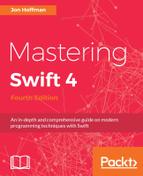Book Description
Dive into the latest release of the Swift programming language with this advanced development book for building highly performant applications.
About This Book
- Harness the latest and most advanced features of Swift 4 to develop quality iOS and macOS applications
- Comprehensive coverage of all the advanced features of Swift and guidance on advanced design techniques
- Dive deep into protocol extensions, learn new error handling model, and use featured Swift design patterns to write more efficient code
- Get to grips with advanced design techniques to write smarter, cleaner Swift code
Who This Book Is For
This book is for developers who want to delve into the newest version of Swift. If you are a developer who learns best by looking at and working with code, then this book is for you. A basic understanding of Apple's tools is beneficial but not mandatory.
What You Will Learn
- Delve into the core components of Swift 4.0, including operators, collections, control flows, and functions
- Create and use classes, structures, and enumerations
- Understand protocol-oriented design and see how it can help you write better code
- Develop a practical understanding of subscripts and extensions
- Add concurrency to your applications using Grand Central Dispatch and Operation Queues
- Implement generics and closures to write very flexible and reusable code
- Make use of Swift’s error handling and availability features to write safer code
In Detail
Swift is the definitive language for Apple development today. It's a vital part of any iOS and macOS developer's skillset, helping them to build the most impressive and popular apps on the App Store—the sort of apps that are essential to iPhone and iPad users every day. With version 4.0, the Swift team has added new features to improve the development experience, making it easier to get the results you want and customers expect.
Inside, you'll find the key features of Swift 4.0 and quickly learn how to use the newest updates to your development advantage. From Objective-C interoperability and ARC to closures and concurrency, this advanced Swift guide will develop your expertise and help you become fluent in this vital programming language.
We'll give you an in-depth knowledge of some of the most sophisticated elements of Swift development, including protocol extensions, error-handling, design patterns, and concurrency. We'll guide you on how to use and apply them in your own projects. You'll see how to leverage the power of protocol-oriented programming to write flexible and easier-to-manage code.
Style and Approach
A Step-by-step advanced guide
Downloading the example code for this book. You can download the example code files for all Packt books you have purchased from your account at http://www.PacktPub.com. If you purchased this book elsewhere, you can visit http://www.PacktPub.com/support and register to have the code file.
